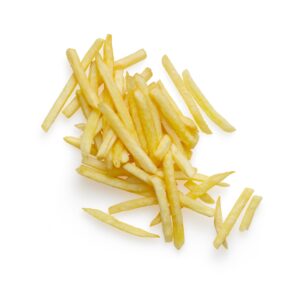Where do chips and fries fit in UPF debate?
Let’s face it — the world of nutrition can be confusing, and the ongoing debate about ultra- processed foods is no exception. Despite the lack of consensus among U.S. nutritionists about the definition of a UPF, the buzz around this topic continues.
More frustrating is that even though most chips and fries do not meet the widely used definition of UPFs, they are often mentioned in a story or shown in an image alongside articles about UPFs.

It is possible to correct this misinformation when armed with an understanding of the definition of UPFs and the argument as to why chips and fries should not be the “poster child” for the movement.
While numerous definitions of UPFs float around the nutrition community, the one that gets the most attention is the NOVA Food Classification system designed at the University of Sao Paulo, Brazil, at the Center for Epidemiological Studies
in Health and Nutrition, School of Public Health.
NOVA was developed in 2010 to help people “group foods according to the extent and purpose of the processing they undergo.” Food processing identified by NOVA involves physical, biological and chemical processes that occur after foods are separated from nature and before they are eaten or used in preparing dishes and meals.
From those considerations, foods are grouped into four categories, listed below.
Unfortunately, the NOVA system contradicts itself in more than one example. For instance, “fatty, sweet, savory, or salty packaged snacks” can be interpreted to include potato chips; however, many unflavored varieties include only three simple ingredients: potatoes, oil and salt, which meets the definition of Group 3.
Moreover, potatoes (Group 1) are a significant proportion of chips and fries, which contradicts the definition of UPF. In some cases, examples of UPFs like ice cream, chocolate milk, and flavored yogurts also meet the definition of Group 3 as they only contain three ingredients and a significant proportion of Group 1 foods.
With this information, writers and editors who mention or use images of chips and fries in stories about UPFs can be asked to correct the content. If you see misinformation or would like more information about media corrections, email Bonnie Johnson at [email protected].

Food categories
Group 1: Unprocessed or minimally processed
- Unprocessed or natural foods come directly from plants or animals and are not altered before they are eaten.
- Minimally processed foods have been cleaned, ground, dried, fermented, pasteurized, or frozen.
- Examples: natural, packaged, cut, chilled or frozen vegetables, fruits, potatoes, and other roots and tubers.
Group 2: Oils, fat, salt and sugar (aka processed culinary ingredients)
- These are food ingredients made from Group 1 “natural foods” by pressing, grinding, crushing, pulverizing, or refining. NOVA acknowledges that these are used in homes and restaurants to season and cook food to create varied and delicious dishes and meals.
- Examples: butter, oil, salt.
Group 3: Processed foods
- Processed foods are manufactured by using salt, sugar, oil, or other substances (Group 2) added to natural or minimally processed foods (Group 1) to preserve or make them more palatable. Most processed foods have two or three ingredients.
- Examples: canned or bottled legumes or vegetables preserved in salt (brine) or vinegar; fruits in sugar syrup; freshly made cheeses; freshly-made (unpackaged) bread made of wheat flour, yeast, water, and salt.
Group 4: UPF
- Ultra-processed foods are “industrial formulations made entirely or mostly from substances extracted from foods (oils, fats, sugar, starch, and proteins), derived from food constituents (hydrogenated fats and modified starch), or synthesized in laboratories from food substrates or other organic sources (flavor enhancers, colors, and several food additives used to make the product hyper-palatable). Manufacturing techniques include extrusion, molding, and preprocessing by frying. Beverages may be ultra-processed. Group 1 foods are a small proportion of, or are even absent from, ultra-processed products.”
- Examples: fatty, sweet, savory, or salty packaged snacks; ice creams; carbonated soft drinks; sweetened and flavored yogurts; chocolate milk.







